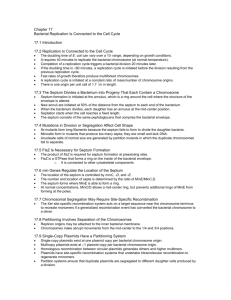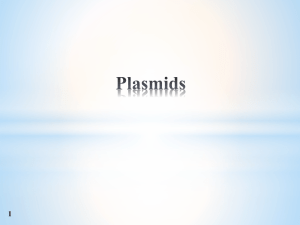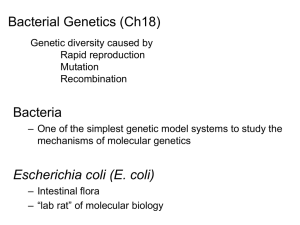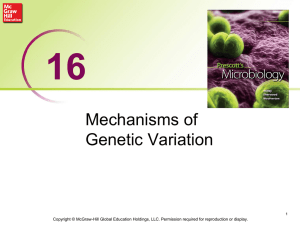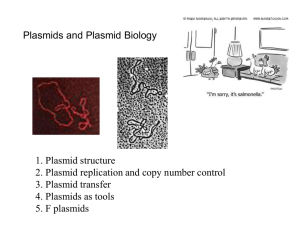Outlines_Ch17
advertisement
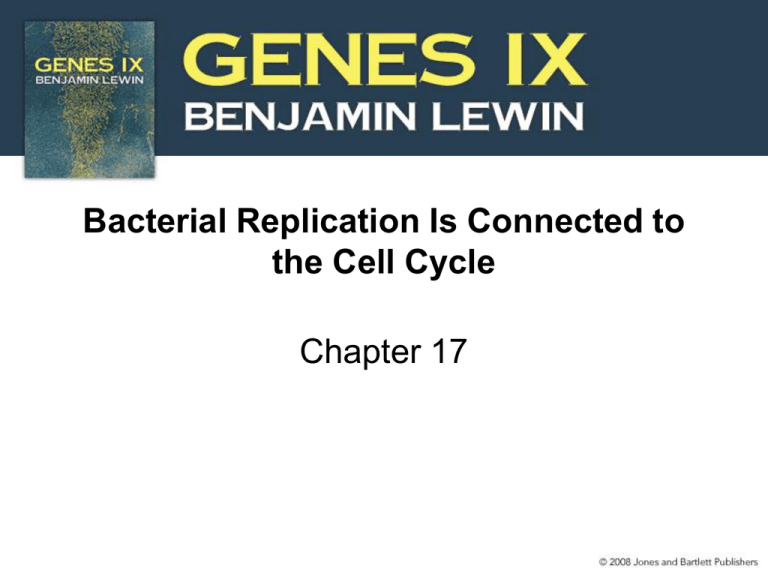
Bacterial Replication Is Connected to the Cell Cycle Chapter 17 17.1 Introduction Figure 17.1 2 17.2 Replication Is Connected to the Cell Cycle • The doubling time of E. coli can vary over a 10× range, depending on growth conditions. • It requires 40 minutes to replicate the bacterial chromosome (at normal temperature). • Completion of a replication cycle triggers a bacterial division 20 minutes later. 3 • If the doubling time is <60 minutes, a replication cycle is initiated before the division resulting from the previous replication cycle. • Fast rates of growth therefore produce multiforked chromosomes. 4 Figure 17.2 • A replication cycle is initiated at a constant ratio of mass/number of chromosome origins. • There is one origin per unit cell of 1.7 μm in length. 5 17.3 The Septum Divides a Bacterium into Progeny That Each Contain a Chromosome • Septum formation is initiated at the annulus. – The annulus is a ring around the cell where the structure of the envelope is altered. • New annuli are initiated at 50% of the distance from the septum to each end of the bacterium. 6 Figure 17.3 • When the bacterium divides, each daughter has an annulus at the mid-center position. • Septation starts when the cell reaches a fixed length. • The septum consists of the same peptidoglycans that comprise the bacterial envelope. 7 17.4 Mutations in Division or Segregation Affect Cell Shape • fts mutants form long filaments because the septum fails to form to divide the daughter bacteria. 8 Figure 17.5 • Minicells form in mutants that produce too many septa; – they are small and lack DNA. • Anucleate cells of normal size are generated by partition mutants. – The duplicate chromosomes fail to separate. Figure 17.6 9 17.5 FtsZ Is Necessary for Septum Formation • The product of ftsZ is required for septum formation at preexisting sites. • FtsZ is a GTPase that forms a ring on the inside of the bacterial envelope. – It is connected to other cytoskeletal components. 10 Figure 17.7 17.6 min Genes Regulate the Location of the Septum • The location of the septum is controlled by minC, -D, and -E. • The number and location of septa is determined by the ratio of MinE/MinC,D. 11 • The septum forms where MinE is able to form a ring. • At normal concentrations, MinC/D: – allows a mid-center ring – prevents additional rings of MinE from forming at the poles 12 Figure 17.9 17.7 Chromosomal Segregation May Require Site-Specific Recombination • The Xer site-specific recombination system acts on a target sequence near the chromosome terminus. – It recreates monomers if a generalized recombination event has converted the bacterial chromosome to a dimer. 13 Figure 17.12 17.8 Partitioning Involves Separation of the Chromosomes • Replicon origins may be attached to the inner bacterial membrane. • Chromosomes make abrupt movements from the mid-center to the 1/4 and 3/4 positions. 14 17.9 Single-Copy Plasmids Have a Partitioning System • Single-copy plasmids exist at one plasmid copy per bacterial chromosome origin. • Multicopy plasmids exist at >1 plasmid copy per bacterial chromosome origin. 15 • Homologous recombination between circular plasmids generates: – dimers – higher multimers • Plasmids have site-specific recombination systems that undertake intramolecular recombination to regenerate monomers. 16 • Partition systems ensure that duplicate plasmids are segregated to different daughter cells produced by a division. 17 Figure 17.15 17.10 Plasmid Incompatibility Is Determined by the Replicon • Plasmids in a single compatibility group have origins that are regulated by a common control system. 18 Figure 17.17 17.11 The ColE1 Compatibility System Is Controlled by an RNA Regulator • Replication of ColE1 requires transcription to pass through the origin. – There the transcript is cleaved by RNAase H to generate a primer end. 19 Figure 17.18 • The regulator RNA I is a short antisense RNA that: – pairs with the transcript – prevents the cleavage that generates the priming end • The Rom protein enhances pairing between RNA I and the transcript. 20 Figure 17.20 17.12 How Do Mitochondria Replicate and Segregate? • mtDNA replication and segregation to daughter mitochondria is stochastic. • Mitochondrial segregation to daughter cells is also stochastic. 21 Figure 17.22
